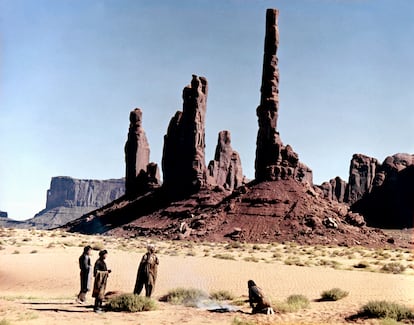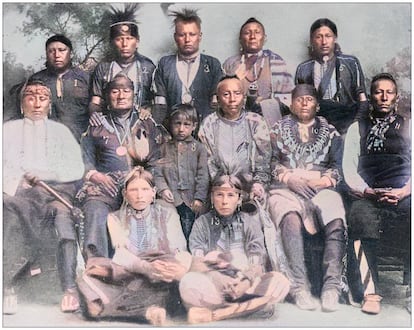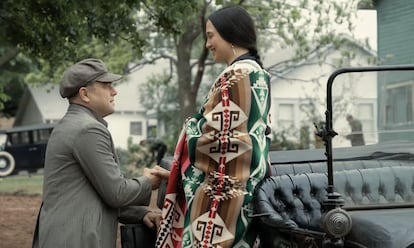When the Navajos fooled John Ford
The difference between the way ‘Cheyenne Autumn’ was shot 60 years ago and the recent ' Killers of the Flower Moon’ reflects Hollywood’s radical change toward Native Americans


At the end of his career, John Ford wanted to use Cheyenne Autumn to apologize to Native Americans for the way he had treated them in his films. Shot in 1964, it was his last western. “There are two sides to every story, but for once I wanted to show their point of view. I’ve killed more Indians than Custer, Beecher and Chivington put together,” the master explained to Peter Bogdanovich in the interview book John Ford. “Let’s face it, we’ve treated them very badly — it’s a blot on our shield. We’ve cheated and robbed, killed, murdered, massacred and everything else, but they kill one white man and, God, out come the troops.”
Cheyenne Autumn recounts a historical episode in which a group of Cheyennes flee to their ancestral lands from the squalid reservation where they are confined and end up being massacred, after being tricked time and again by U.S. authorities. The problem is that Ford shot in Monument Valley, the setting for his great Westerns, which belongs to a Navajo reservation. Members of this tribe acted massively in the film, in which Mexican actors also play Native Americans. It is something that would be impossible to explain to the public today, but Ford had no choice if he wanted to shoot the film.
Of course, the Navajos who were playing Cheyennes took their revenge on the white men. Since no one but them understood Navajo on the set — a language so difficult that it was used as a secret code during World War II — instead of reading the script they decided to say whatever they wanted. They made all sorts of comments about the small size of the white officers’ penises and other nonsense during the film’s most tragic scenes. At least, that’s what an old Hollywood legend says, but John Ford made the doctrine clear at the end of The Man Who Shot Liberty Valance: “This is the West: when the legend becomes a fact, print the legend.”

Author Tony Hillerman wrote a series of noir novels set on the same Navajo reservation where Ford filmed Cheyenne Autumn, and his books serve as the basis for the terrific series Dark Winds (the two seasons can currently be seen on AMC+). In one of them, Sacred Clowns, he describes a drive-in movie theater in Gallup where Navajos used to see the film again and again. Jim Chee, one of the policemen who stars in the show, recounts that at the screening “they would honk their car horns and laugh their heads off” at what were, in theory, the most dramatic moments. And he recalls what he felt when he attended a session with a Cheyenne who didn’t understand Navajo: “In the exact same scene, he was watching the destruction of his culture. We were watching as our people laughed at the whites.”
None of this could have happened to Martin Scorsese, another director at the height of his creative powers, who tried his hand at westerns at age 81 with Killers of the Flower Moon (available on Apple TV). The Osage tribe plays an essential role in the film, which has garnered 10 Oscar nominations. Set in the 1920s, the film tells the story of how dozens of Osage were murdered with impunity to steal the property rights to their oil wells. Scorsese not only relied on numerous Native advisors to lend credibility to the film, but he also worked directly with tribal representatives. Of the 63 Native American actors in the film, 49 are Osage.

Both Ford and Scorsese wanted to remember a forgotten history, buried by a vision of the past in which the roles are totally reversed — the invaders became the invaded, and vice versa. In fact, David Grann, the New Yorker journalist on whose book, Killers of the Flower Moon, Scorsese’s film is based, notes that it was precisely the will to remember something that should never have been forgotten that led him to investigate the crimes against the Osage for years. “One day in the summer of 2012, fresh from New York, where I live and work as a journalist, I visited Pawhuska for the first time hoping to find information about the murders that had occurred almost a century ago. Like most Americans, when I was in school I never read any books about these crimes; it was as if they had been erased from history. So, I started researching when I stumbled upon a reference to those events. From then on, I was consumed with the urge to solve the unanswered questions, to tie up the loose ends that the FBI investigation didn’t.”
The star of the film, Lily Gladstone, has a good chance of becoming the first Native American actress to win an Oscar. For the movie, she took lessons in Osage culture, which included the stories that ground the group’s traditions as well as the language. “There are elements in this film that just scream Osage,” Jim Gray, one of the tribal members who helped make the film, told The Harvard Gazette. “Even though 99 percent of the audience will be non-Osage and are not going to know as much about this story as we do, Osage people sitting in the audience are going to get a lot of the observances that Scorsese incorporated into the film that could only have come from collaboration with the tribe.”
Decolonizing — museums, mentalities, the vision of the past — also represents the different way in which two masters of cinema, Ford and Scorsese, faced the same problem 60 years apart: telling the story of the United States from the perspective of those who were exterminated.
Sign up for our weekly newsletter to get more English-language news coverage from EL PAÍS USA Edition
Tu suscripción se está usando en otro dispositivo
¿Quieres añadir otro usuario a tu suscripción?
Si continúas leyendo en este dispositivo, no se podrá leer en el otro.
FlechaTu suscripción se está usando en otro dispositivo y solo puedes acceder a EL PAÍS desde un dispositivo a la vez.
Si quieres compartir tu cuenta, cambia tu suscripción a la modalidad Premium, así podrás añadir otro usuario. Cada uno accederá con su propia cuenta de email, lo que os permitirá personalizar vuestra experiencia en EL PAÍS.
¿Tienes una suscripción de empresa? Accede aquí para contratar más cuentas.
En el caso de no saber quién está usando tu cuenta, te recomendamos cambiar tu contraseña aquí.
Si decides continuar compartiendo tu cuenta, este mensaje se mostrará en tu dispositivo y en el de la otra persona que está usando tu cuenta de forma indefinida, afectando a tu experiencia de lectura. Puedes consultar aquí los términos y condiciones de la suscripción digital.










































